Webinar text. Page 2
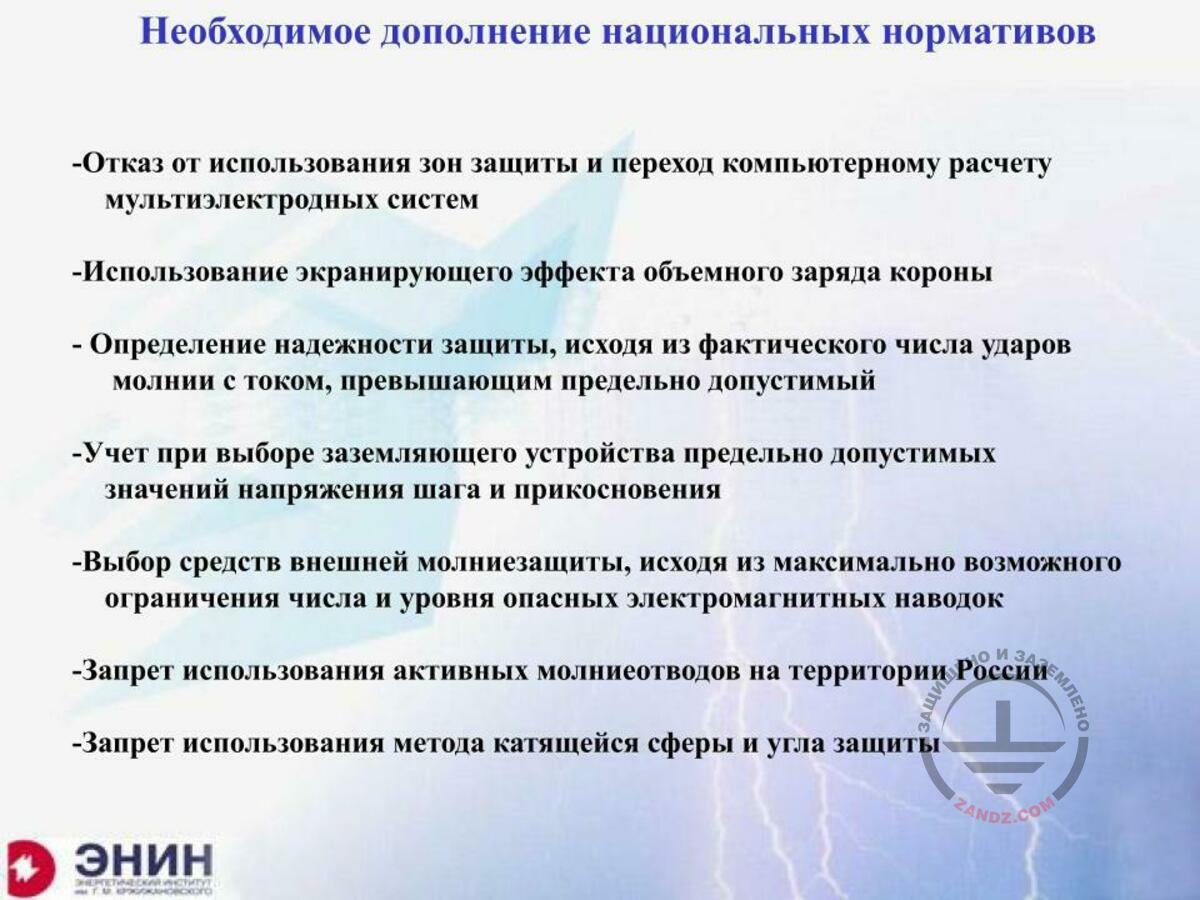
Required addition to the national standards
Необходимое дополнение национальных нормативов
- Отказ от использования зон защиты и переход компьютерному расчету мультиэлектродных систем
- Использование экранирующего эффекта объемного заряда короны
- Определение надежности защиты, исходя из фактического числа ударов молнии с током, превышающим предельно допустимый
- Учет при выборе заземляющего устройства предельно допустимых значений напряжения шага и прикосновения
- Выбор средств внешней молниезащиты, исходя из максимально возможного ограничения числа и уровня опасных электромагнитных наводок
- Запрет использования активных молниеотводов на территории России
- Запрет использования метода катящейся сферы и угла защиты
Required addition to the national standards
- Refusal to use the protection zones and transition to the computer calculation of multi-electrode systems
- Use of a shielding effect of the bulk crown charge
- Determination of the protection reliability based on the actual number of strikes of lightnings with the current exceeding the maximum allowable level
- Considering maximum allowable step and touch voltages when choosing the earthing device
- Choosing the external lightning protection devices based on the maximum possible limitation in the number and the level of dangerous electromagnetic interference
- Prohibition to use active lightning arrester within the Russian Federation
- Prohibition to use a rolling sphere method and protection angles
And if the situation is poor with the devices, let's talk about papers. Why have I determined the improvement of the regulatory documents for lightning protection as an important aspect for the future of lightning protection? This issue needs a very serious analysis. The first issue is: whatever you do, the designers continue using the protection zones to calculate lightning arresters. This is so much the case that yesterday, we intentionally discussed the issue of writing a series of articles that would cause the designers to refuse choosing the lightning arresters according to the protection zones, because it is not feasible. And this is the first issue that has to be solved by the authors of regulatory documents. The second issue: among all types of lightning exposure, shielding the system with a bulk charge created by the crown is the only real and cheap path because it does not require any additional high voltage sources. And the benefits of the lightning arresters that use the crown shielding effect must be included in the regulatory documents. It is the second aspect. The third aspect relates to choosing the earthing devices. The lightning has been caught by the lightning arrester, and it attracted the lightning securely. Then, the lightning current goes to the earth, and after this, around this lightning arrester, the system that is very similar to the normal electric chair used in America is created. So, we must necessarily eliminate such electric chair around the lightning arresters. And the fourth aspect is: we protect the facilities against the lightning. But do we need to protect facilities against it? The facilities must be protected not from the lightnings but from the dangerous lightnings. For each structure, whether it is an aircraft, a rocket, or a residential building, a dangerous lightning current exists. And if the current value is lower, then let them strike the facility. Therefore, we have to learn how to design such lightning arresters that reduce the number of dangerous effects rather than only a number of lightning strikes. And finally, we have to get rid of the false information.
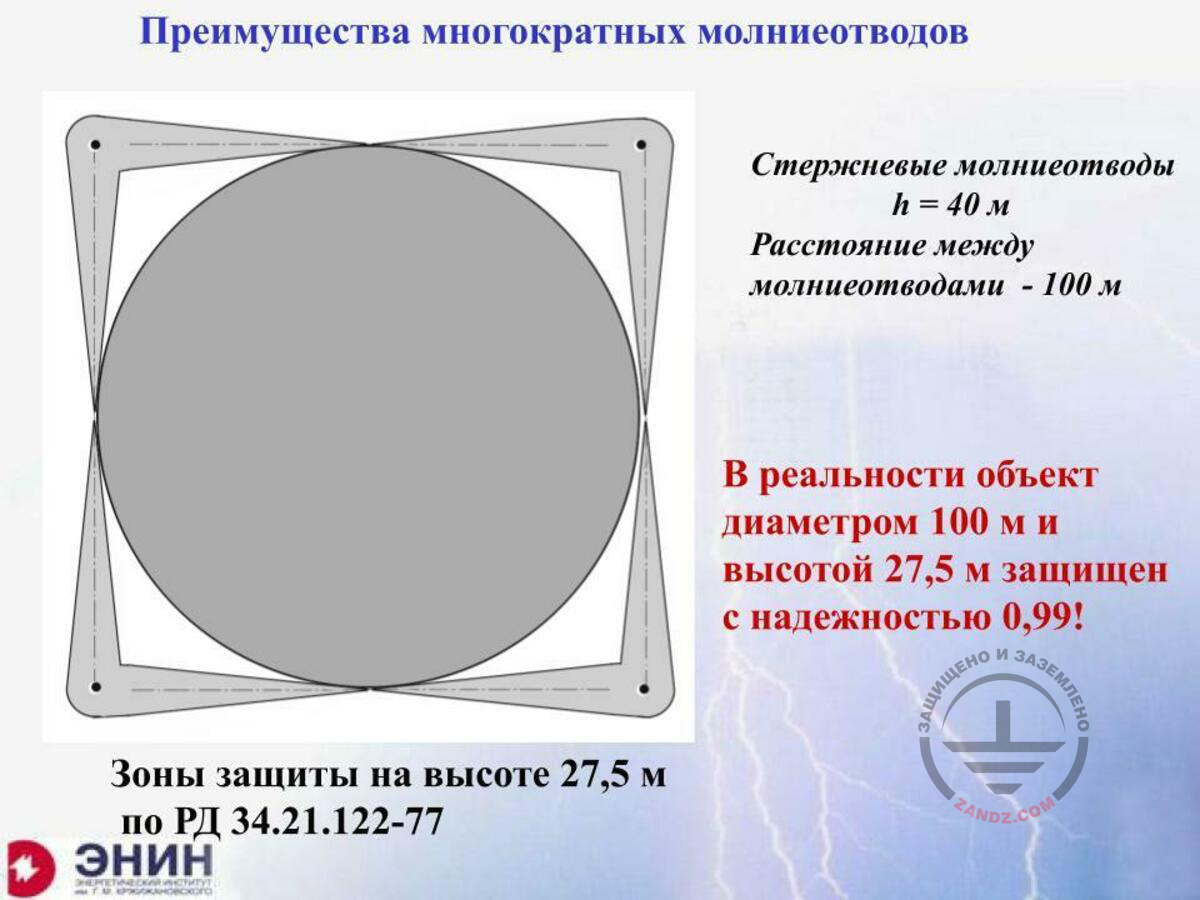
Benefits of multiple lightning arresters
Преимущества многократных молниеотводов
Стержневые молниеотводы h = 40 м
Расстояние между молниеотводами – 100 м
В реальности объект диаметром 100 м и высотой 27,5 м защищен с надежностью 0,99!
Зоны защиты на высоте 27,5 м по РД 34.21.122-77
Benefits of multiple lightning arresters
Lightning rods h = 40 m
Distance between the lightning arresters — 100 m
In the real life, the facility with a diameter of 100 m and a height of 27.5 m is protected with a reliability of 0.99!
Protection zone at the height of 27.5 m according to RD 34.21.122-77
And I want to show you how significant it could be. Let me provide an example: the circle you can see on the screen is a large tank farm having a diameter of 100 meters, and a height of 27.5 meters, and it should be protected by the lightning arresters. If I install the lightning arresters of 40 meters high and calculate their protection area according to the protection zones, then it will turn out that all the items in the center will not be protected, the height of the lightning arresters has to be very high, and it means more than extra money for high lightning arresters. Again, we can solve the money issue. But the point is that if you make these lightning arresters not 40 meters but, for example, 80 meters high, which is almost the way it is made in a French design I have seen, then the number of lightning strikes into these lightning arresters will increase about 4-fold. And if the number of strikes will increase 4 times, then the number of electromagnetic effects will also increase 4 times, and they will affect the automation equipment of this tank. Who needs that? Nobody. The more so as, indeed, these four lightning arresters, if we calculate their collective active impact rather than do it according to their protection zones, it turns out that they protect the tank farm with a reliability of 0.99. But we have to remove these protection zones. And we will talk about it again and write the articles.
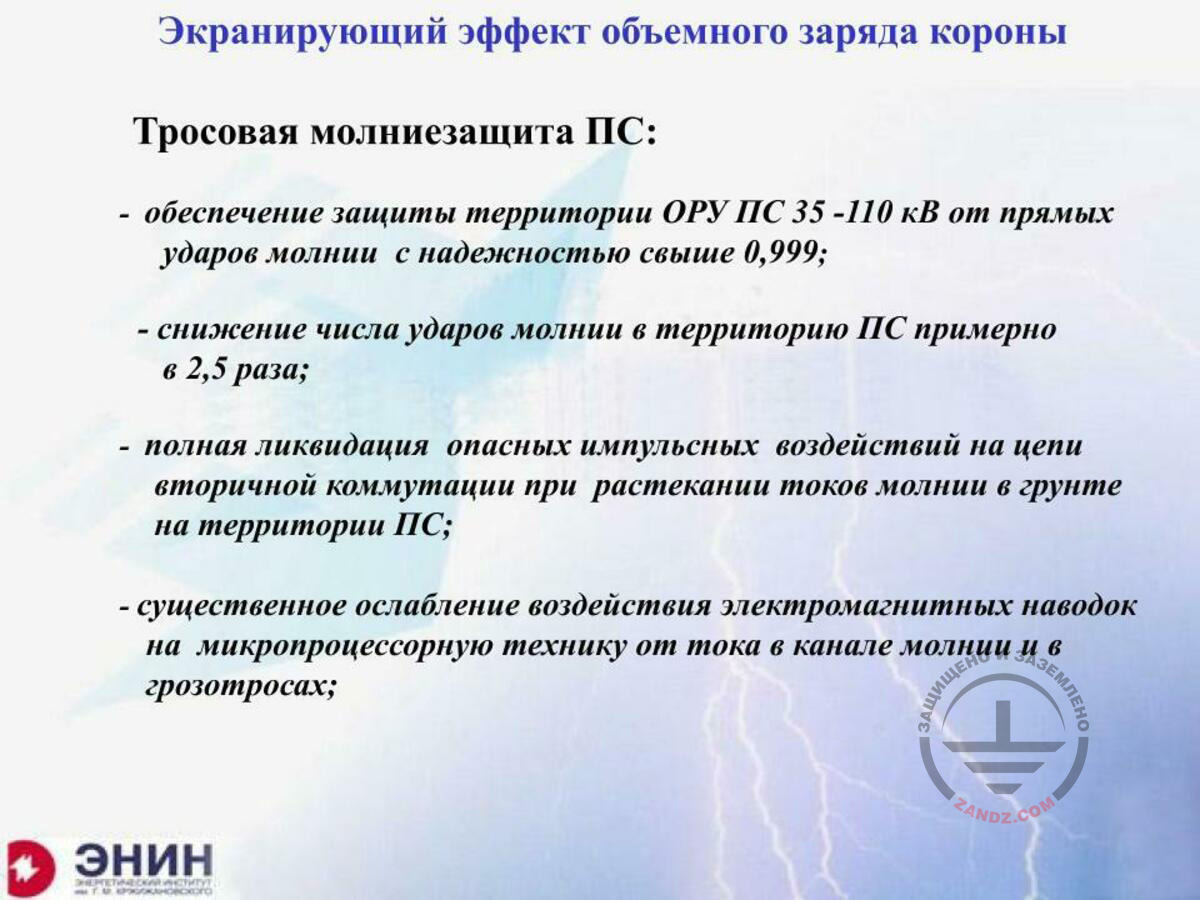
Shielding effect of the bulk crown charge
Экранирующий эффект объемного заряда короны
Тросовая молниезащита ПС:
- обеспечение защиты территории ОРУ ПС 35-110 кВ от прямых ударов молнии с надежностью свыше 0,999;
- снижение числа ударов молнии территорию ПС примерно в 2,5 раза;
- полная ликвидация опасных импульсных воздействий на цепи вторичной коммутации при растекании токов молнии в грунте на территории ПС;
- существенное ослабление воздействия электромагнитных наводок на микропроцессорную технику от тока в канале молнии и в грозотросах;
Shielding effect of the bulk crown charge
Wire lightning protection for the substation:
- providing the protection of the territory of the 35–110 kV open distribution device substation from the direct lightning strikes with a reliability of over 0.999;
- reducing the number of lightning strikes into the substation territory about 2.5-fold;
- fully eliminating the dangerous pulse effects of the secondary commutation circuits in the lightning current flowing in the soil in the substation territory;
- significantly alleviating the electromagnetic interference impact on the microprocessor hardware from the current in the lightning channel and in the ground wires;
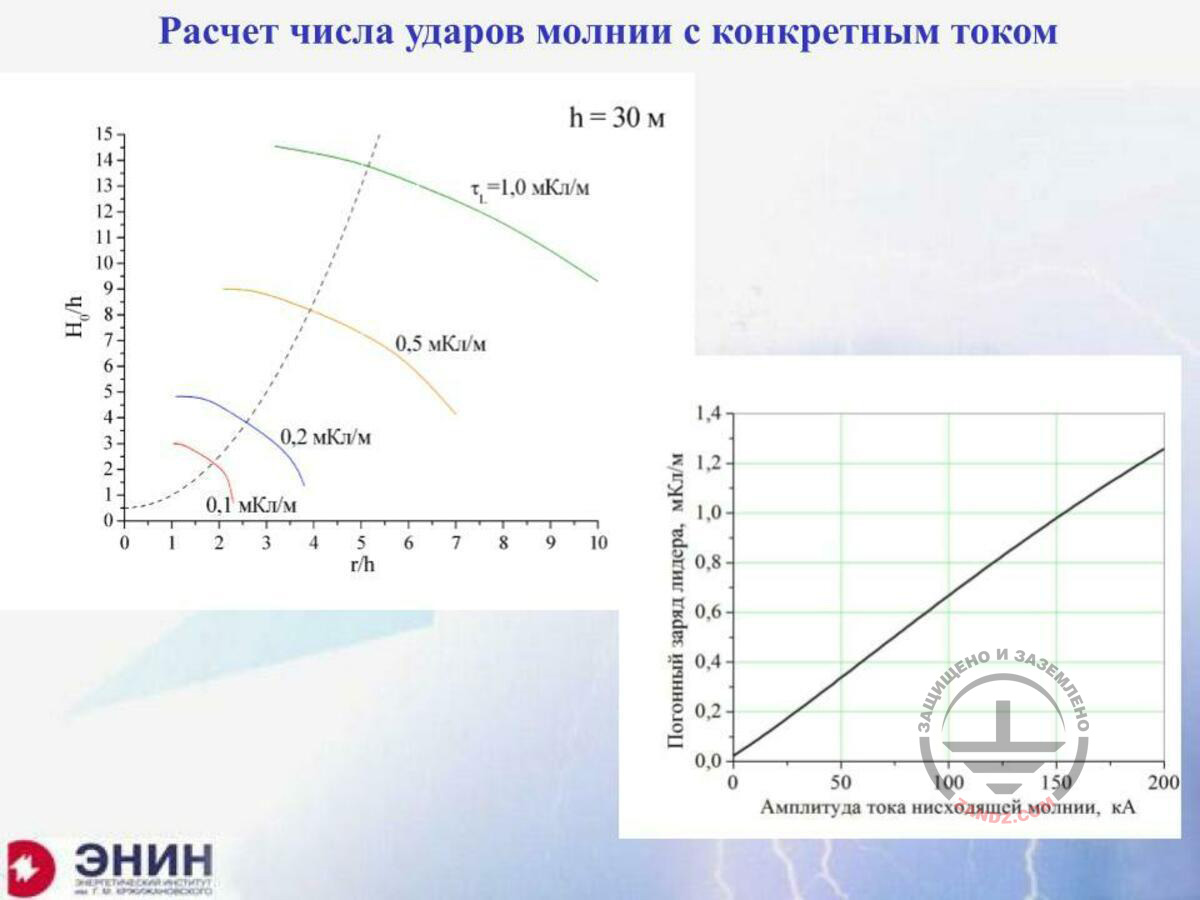
Calculation of a number of lightning strikes with a particular current
Расчет числа ударов молнии с конкретным током
h = 30 м
мКл/м
Погонный заряд лидера, мКл/м
Амплитуда тока нисходящей молнии, кА
Calculation of a number of lightning strikes with a particular current
h = 30 m
mC/m
Linear leader charge, mC/m
Current amplitude of the downward lightning, kA
Now, what can we say about the protective action of the lightning arresters in terms of the lightnings with various currents? Today, we have a methodological structure that allows two things. First, it allows calculating the number of lightning strikes with the fixed currents. I am interested not in the lightning strikes in general but in the lightning strikes with the current of not less than 58 kA. And today, I may develop a calculation structure that can do that. And I cannot just develop such calculation structure but develop a structure for such calculations for the lightning arresters having a particular height. It will be certain for the lightning arresters of twenty meters high and it will be different for the lightning arresters of one hundred meters high. Can you see that? Today, the level of calculations of this type is ready to use, although we do not have a regulatory framework to implement such calculations in practice. Therefore, I think that the development of the national regulatory document for the new generation of lightning protection will lead to the implementation of our knowledge and skills in practice because ideas of the lighting can only be implemented if they are legalized. And it cannot be different. Can you see that? We hoped very much that such new-generation regulatory framework would be supported by the Academy of Sciences. It is pretty difficult to talk about such support today. And I feel sorry about that.
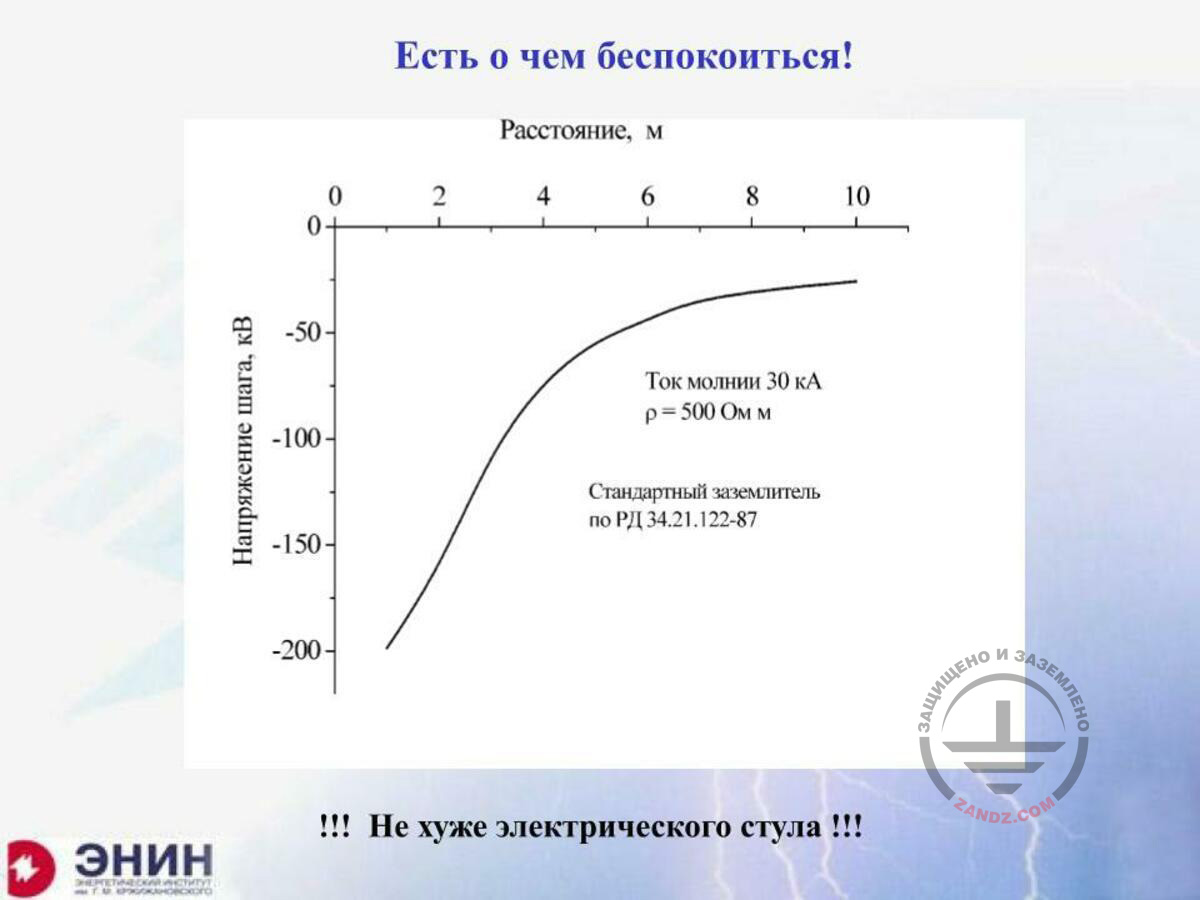
We have something to worry about!
Есть о чем беспокоиться!
Расстояние, м
Напряжение шага, кВ
Ток молнии 30 кА
Ом м
Стандартный заземлитель по РД 34.21.122-87
!!! Не хуже электрического стула!!!
We have something to worry about!
Distance, m
Step voltage, kV
Lightning current of 30 kA
Ohm m
Standard earthing device according to RD 34.21.122-87
!!! Better than the electric chair!!!
And now, I want to tell you about the earthing device. I mentioned that we have regulatory requirements to the earthing devices. For example, they exist in RD 34. You know them well because they state what structures of the earthing devices of the lightning arresters may be used. I have taken a typical structure of the lightning arrester from RD 34. Remember that it includes the horizontal band of up to 15 meters and three vertical rods of 3 or 5 meters depth. I have taken such system. I have made such system in the soil with 500 Ohm*m. It is widespread in Russia. Certainly, this is not a good soil, and this is not a rock soil; it is a typical soil that is common for Russia. And I looked at what the lightning with the average parameters of the 30 kA current can do. According to the current regulatory requirements, you do not have to do anything with such lightning arrester. It is all fine. Install a lightning arrester, make such earthing device and go to sleep. But this is what happens in reality. Here, I have a distance from the lightning arrester, and below are kilovolts of the step voltage for a person that is standing near this lightning arrester. At the distance of 2 meters, it will be exposed to the voltage of 150 kV, and at the distance of 10 meters, it will be exposed to the voltage of about 25 kV, i.e. you actually make and install a normal electric chair in the street.
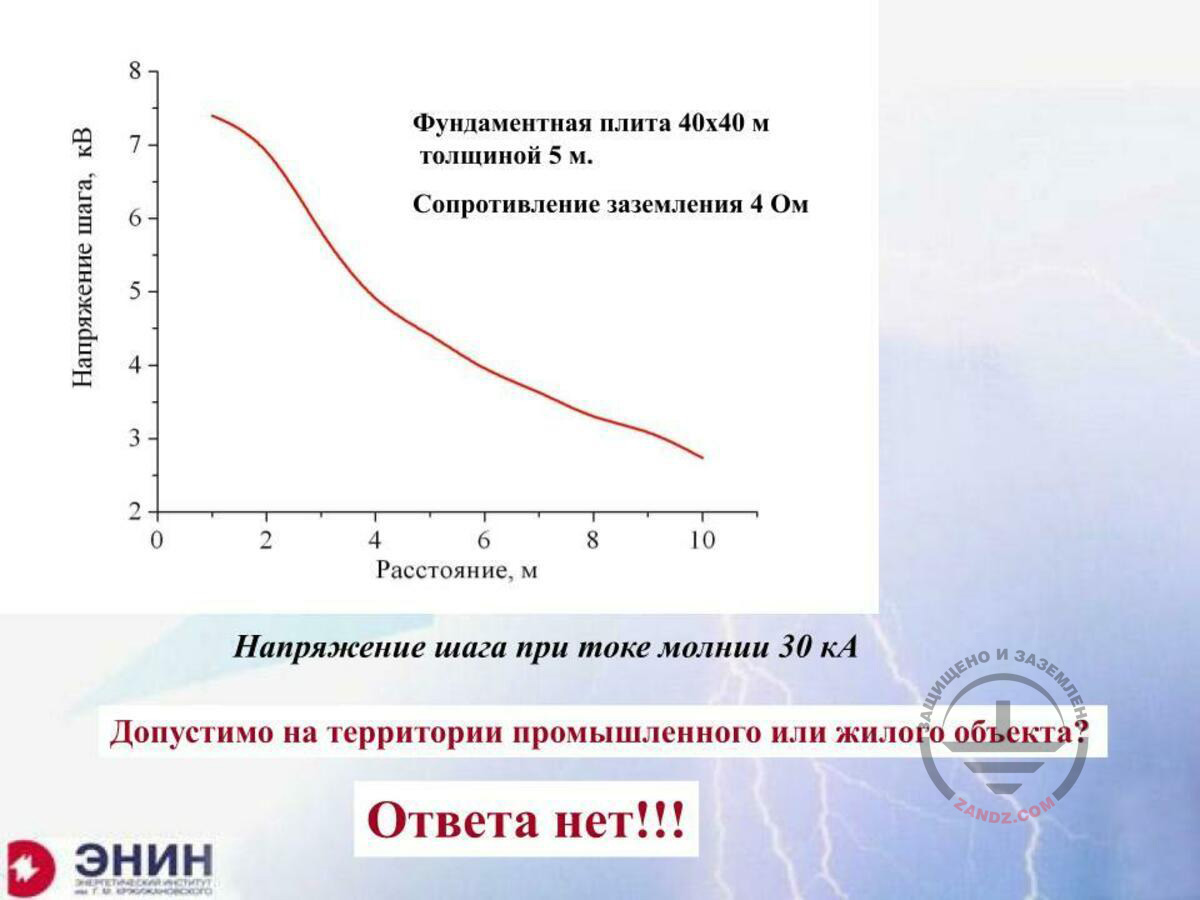
Step voltage with the 30 kA lightning current
Напряжение шага, кВ
Расстояние, м
Фундаментная плита 40х40 м толщиной 5 м.
Сопротивление заземления 4 Ом
Напряжение шага при токе молнии 30 кА
Допустимо на территории промышленного или жилого объекта?
Ответа нет!!!
Step voltage, kV
Distance, m
Foundation plate of 40 x 40 m and 5 m thick.
Earthing resistance is 40 Ohm
Step voltage at the 30 kA lightning current
Is it acceptable for the industrial or residential facility?
No answer!!!
But that is fine if it is a lightning arrester. The problem is that the building foundations also serve as lightning arresters as it is permitted in our practice. And I have taken such foundation. I have a high-rise building and, therefore, it has a foundation made of a plate of 40 x 50 meters and 5 meters thick filled with the metal reinforcement. I have taken such a plate and again, I calculated the step voltage around it considering the average 30 kA lightning current. I obtained the distance, and kilovolts are shown above. Surely, kilovolts here are lower than in the earthing device of the lightning arrester, but in any case, at the distance of somewhere near this building pavement, a passing person will be exposed to the voltage of several kilovolts. And the question arises: is it high or low? You will not find any regulatory document that shows what voltage is acceptable for a person when it is exposed to a voltage of about 10 kV. Will he/she stay alive or not? Since those who work with high voltages have been exposed to them, we remember it for a long time. But the regulatory documents contain nothing about it. And we can leave this as it is and look at people’s sufferings because our regulatory framework is absolutely imperfect. That is why I am talking about the regulatory framework.
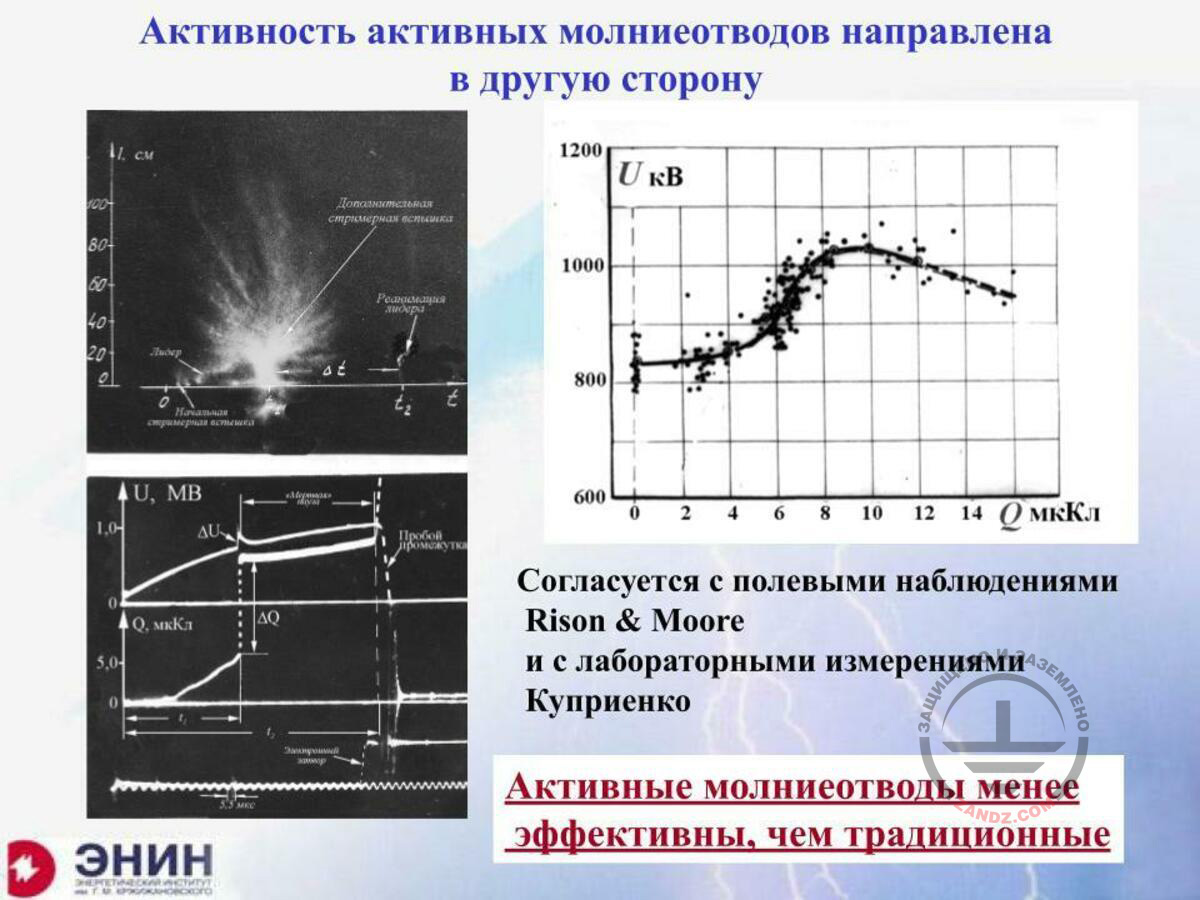
Activity of the active lightning arresters is directed to the other side
Активность активных молниеотводов направлена в другую сторону
Согласуется с полевыми наблюдениями Rison & Moore и с лабораторными измерениями Куприенко
Активные молниеотводы менее эффективны, чем традиционные
Activity of the active lightning arresters is directed to the other side
Matches with the field observations of Rison & Moore and laboratory measurements of Kuprienko
Active lightning arresters are less efficient than the conventional arresters
I have told much about the active lightning arresters. Unfortunately, we do not have any doubts today about the following. As the active lightning arresters are manufactured today by the manufacturers that operate in the market, their active exposure leads to the reduction in the protective action of the lightning arrester but not to its increase.
<< Previous page
slides from 1 to 7
Next page >>
slides from 15 to 19 + Questions and answers
Related Articles:
 Lightning Protection of Large Territories: Parks, Grounds, Plant Territories. Page 1
Lightning Protection of Large Territories: Parks, Grounds, Plant Territories. Page 1
 Lightning Protection of Large Territories: Parks, Grounds, Plant Territories. Page 2
Lightning Protection of Large Territories: Parks, Grounds, Plant Territories. Page 2
 Lightning Protection of Large Territories: Parks, Grounds, Plant Territories. Page 3
Lightning Protection of Large Territories: Parks, Grounds, Plant Territories. Page 3

